 Q: Why is root canal treatment necessary?
Q: Why is root canal treatment necessary?
Q: What are typical symptoms of a tooth that requires root canal treatment?
Q: What is involved in root canal treatment to save my tooth?
Q: What can I expect following the procedure?
Q: Can an infected tooth cause a general body infection?
Q: Who is qualified to perform root canal treatment?
Q: How is cost covered?
Q: Can all teeth be treated endodontically?
Q: Why have I been referred for root canal treatment/ why can my dentist not do it?
Q: Why is this referral for root canal treatment private and not on the NHS
Q: Why do root canal treatments fail/ Why is a second root canal treatment (retreatment) necessary?
Q: How do I know if retreatment is the best choice and what are the alternatives?
Q: What does retreatment involve?
Q: Who performs root canal retreatment and what are the costs?
Basic Questions about root canal treatments
The term “root canal” can send shivers down ones spine. However, these are nothing more than outdated myths. In fact, the whole purpose of a root canal treatment is to remove or eliminate the pain. Root canal treatments are often a pain-free experience.
Q: Why is root canal treatment necessary?
Root canal or endodontic treatment (endo-inside, dont-tooth) is necessary when the inside, or pulp of a tooth becomes inflamed or infected. This may be due to:
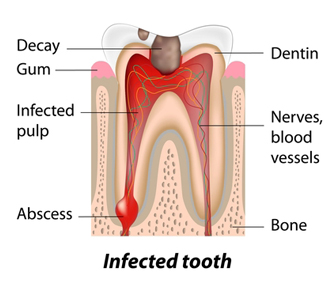 The pulp contains the nerves and blood vessels and is what keeps the tooth alive and allows you to perceive temperature change and pain. When the pulp is irreversibly damaged it causes toothache and severe pain. By removing the pulp and disinfecting the pulp chamber we are able to eliminate the pain and is the last resort to saving the tooth. After a root canal treatment is undertaken we are essentially left with a shell of the tooth without a pulp (nerve or blood supply) but the tooth is still functional.
The pulp contains the nerves and blood vessels and is what keeps the tooth alive and allows you to perceive temperature change and pain. When the pulp is irreversibly damaged it causes toothache and severe pain. By removing the pulp and disinfecting the pulp chamber we are able to eliminate the pain and is the last resort to saving the tooth. After a root canal treatment is undertaken we are essentially left with a shell of the tooth without a pulp (nerve or blood supply) but the tooth is still functional.Q: What are typical symptoms of a tooth that requires root canal treatment?
Some of the signs or symptoms that require root canal treatment are:
Please note that the signs and symptoms above do not always mean a tooth requires root canal treatment. The tooth needs to be carefully assessed by a dentist.
Q: What is involved in root canal treatment to save my tooth?
To gain access to the pulp a small hole is prepared in the biting surface of the tooth. The dead and dying tissue is carefully removed using special instruments and the root canals are cleaned and disinfected.
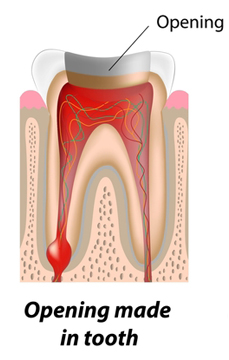
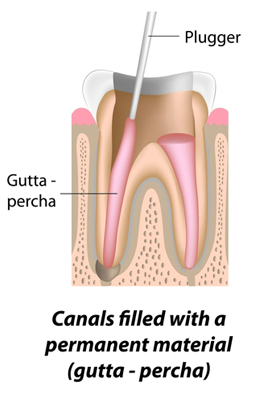
A biocompatible filling material (gutta percha) is used to fill the specially shaped and disinfected root canals.
A temporary restoration is placed when the root canal is completed and the patient is handed back to your referring dentist for final restoration of the tooth.
Q: What can I expect following the procedure?
For the first few days after treatment, the tooth may feel tender or sensitive. Most discomfort can be relieved by using over-the-counter (OTC) medication like paracetamol or ibuprofen. If the discomfort or pain lasts more than a few days or if there is other increasing symptoms is best to seek advice from the dentist. Prescription medications including antibiotics may be indicated.
Care should be exercised when chewing and biting on a root treated tooth particularly if part of the tooth was lost to decay, a large filling or trauma, until final restoration.
After the final root canal treatment visit you will be returned to the referring dentist to have a crown or other restoration placed on the tooth to protect and restore it to full function. If the tooth lacks sufficient tooth structure, a post may become necessary to hold the restoration in place but this is not always indicated.
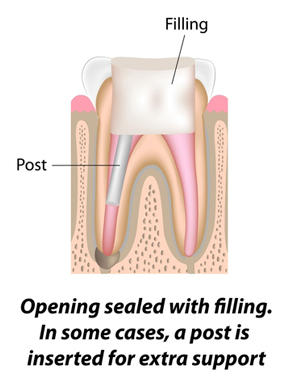
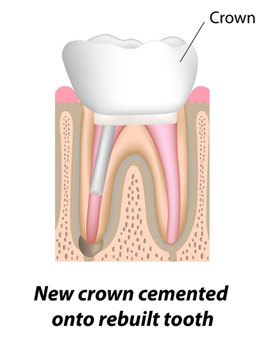
Q: Can an infected tooth cause a general body infection?
Usually the infections associated with root canal infection are localised to the area around the root of that particular tooth. Occasionally an infection associated with an untreated root canal infection can cause swelling, pain and can on the very rare occasion lead to a serious life threatening infection. It is advisable not to wait to get a root canal treatment done, just because it has stopped hurting. Root canal treatment is designed to disinfect the tooth and stop spread of infection making it safe and effective treatment option.
Q: Who is qualified to perform root canal treatment?
All general dentists have received training in providing root canal treatment on simple straightforward cases. When a particular case is more complex the dentist will often refer the patient to a dentist with specialist skills in root canal treatment. These dentists in addition to undergoing further training also have additional equipment like an operating microscope. A microscope is now essential to be able to make the cleaning and shaping more effective.
The cost varies depending on how complex the case is and which tooth is affected. Cost is based on the number of root canals, degree of difficulty and location of the tooth in the mouth; for example, front teeth are easier to treat than back teeth. Link to cost / fee guide
Q: Can all teeth be treated endodontically?
Most teeth can be treated.
Teeth cannot be root treated usually because:
However, advances in root canal treatment and the equipment used now allow us to save teeth that in the past had to be removed.
Q: Why have I been referred for root canal treatment/ why can my dentist not do it?
All general dentists have received training in providing root canal treatment on simple straightforward cases. When a particular case is more complex the dentist will often refer the patient to a dentist with specialist skills in root canal treatment. These dentists in addition to undergoing further training also have additional equipment like an operating microscope and other pieces of equipment. A microscope is now essential to be able to undertake more complex root canal treatments. Mr Khatri at our practice has completed an MSc. in Endodontics (Root Canal Treatments) and accepts referrals from other dentists. He undertakes all root canal treatment using an operating microscope.
The American Association of Endodontists has a case difficulty assessment form to help dentists identify which cases are more complex. Please click on the link below if you want to try and assess where your case fits in (you may find some of the terms technical):
Q: Why is this referral for root canal treatment private and not on the NHS
All general dentists have received training in providing root canal treatment on simple and straight forward cases. However for more complex cases your dentist will discuss with you possible next steps on the NHS and private options for treatment.
A restorative advice (including root canal treatments) and treatment planning service is available at Northampton General Hospital, however this is limited to one day per month. Patients may be referred back to the referring dentist for treatment if it is within the scope of General Dental Services in the opinion of the Consultant in Restorative Dentistry.
Your dentist can send referrals to Mrs Adi Mosaku (Consultant in Restorative Dentistry). Where Mrs Mosaku feels that the case is complex and beyond the scope of the referring dentist, she is able to refer patients on occasion to Diane Fenton (Dental contract manager of Hertfordshire and South Midlands area team) who is able to consider patients on a case-by-case basis for referral for specialist root canal treatments to Milton Keynes. It is therefore best for discussion around saving teeth to be between your referring dentist and patients.
At present referral for complex root canal treatment to our practice is on a private basis only.
Q: Why do root canal treatments fail/ Why is a second root canal treatment (retreatment) necessary?
On occasion a tooth may not respond to treatment as anticipated as often happens with medical and dental treatment. This for example may be due to:
Narrow or curved root canals sometimes pose complications during the initial procedure.
Complicated root canal anatomy (shapes and forms) was undetected in the first procedure eg calcified canals or accessory canals.
An inadequate seal of a restoration (filling) allowed recontamination of the inside of the tooth.
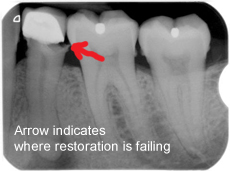 Secondary decay (decay under an existing restoration) can expose the root canal filling material to bacteria, causing it to fail.
Secondary decay (decay under an existing restoration) can expose the root canal filling material to bacteria, causing it to fail.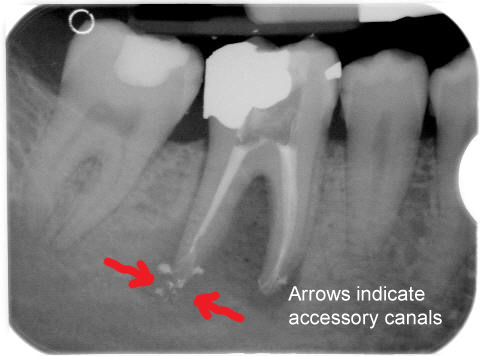 Accessory or lateral canals are part of a complicated root canal anatomy. Root canals, which house the contents of the pulp of a tooth (blood vessels, nerves and connective tissues), can be quite complex, like the root system of a tree or plant. The root canal system of a tooth may have tiny branches coming off the main canals.
Accessory or lateral canals are part of a complicated root canal anatomy. Root canals, which house the contents of the pulp of a tooth (blood vessels, nerves and connective tissues), can be quite complex, like the root system of a tree or plant. The root canal system of a tooth may have tiny branches coming off the main canals.These accessory canals can sometimes be quite difficult to detect, clean and fill. If tissue is trapped inside one of them, it can become infected and die. If your tooth has failed to heal or has developed new problems, you may have a second chance. An additional root canal procedure may be able to save your tooth. This is called retreatment.
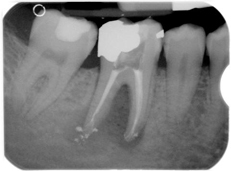 While challenging, accessory canals can be successfully treated to save an affected tooth. This often requires specialist skills in the diagnosis and treatment of root canal disorders and advanced technologies such as microscopes and specialised filling techniques to treat these minute canals.
While challenging, accessory canals can be successfully treated to save an affected tooth. This often requires specialist skills in the diagnosis and treatment of root canal disorders and advanced technologies such as microscopes and specialised filling techniques to treat these minute canals.Often after taking x-ray a dentist will find that the root canal treatment done many years ago is failing and recommend a retreatment. The patient may have no pain or symptoms from a failing root canal treatment.
Occasionally even a recent root treated tooth may have symptoms of pain and discomfort on biting down, and a referral for retreatment may be required.
Some of these issues do not give rise to symptoms, but can give rise to chronic infection, often seen in an x-ray picture as a small black area around the end of an affected root.
Q: How do I know if retreatment is the best choice and what are the alternatives?
Whenever possible, it is best to save your own natural tooth. Retreated teeth can function well for years, even a lifetime. Advances in technology in root canal treatments, make this possible. The only other alternative to retreatment or failing root canal treatment is an extraction of the tooth. Extracted teeth can be replaced with implants, bridge or removable partial denture to restore function and aesthetics and importantly, to prevent adjacent teeth from shifting. These options require surgery or dental procedures on adjacent healthy teeth, they are often more costly and time consuming than retreatment and restoration of the natural tooth. The most conservative procedure is almost always always the best option.
Q: What does retreatment involve?
The previously root treated tooth will have to be “reopened”. A small hole is made into the biting or chewing surface of the tooth to gain access to the root canal. In many cases, complex restorative materials — crown, post and core material — must be “disassembled” and removed to permit access to the root canals. The previous root canal filling materials is removed and the canals cleaned and carefully examined, usually requiring magnification and illumination, which includes searching for any additional canals or unusual canal anatomy using an operating microscope. After cleaning and shaping the canals they will be filled and a temporary filling or crown placed.
Upon successful completion and healing of infection, a new crown or restoration will need to be placed on the tooth to protect and restore it to its full form and function.
Q: Who performs root canal retreatment and what are the costs?
Endodontic or root canal retreatment is more complicated and technically challenging than initial treatment, and is generally carried out by dentists who have specialist skills and who have taken on additional training in the diagnosis and treatment of root canal problems.
The cost varies depending on complexity and the time needed. Teeth with multiple canals, like the back (premolar and molar) teeth are more time consuming especially if there are extra or unusually shaped canals. Restorations and filling material may also need to be removed to re-access the root canal. Therefore, retreatment cost more than the initial root canal treatment.
